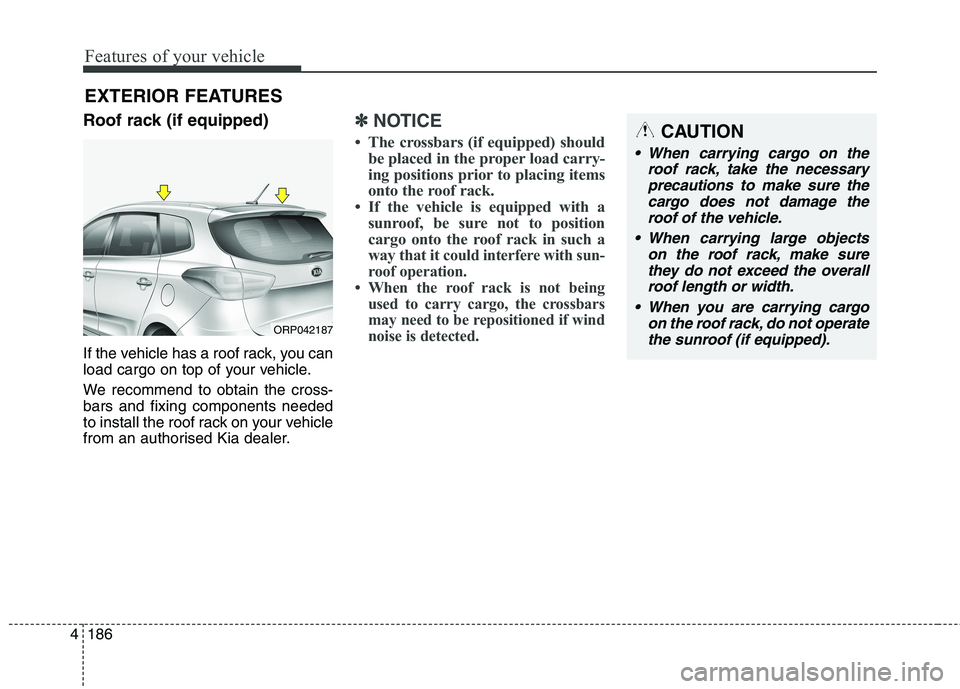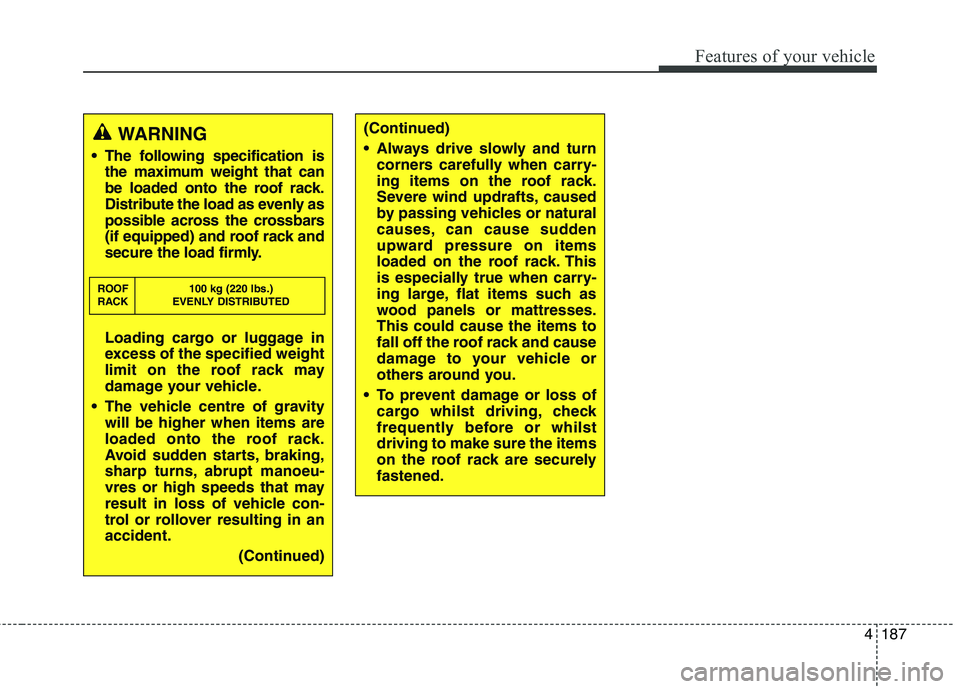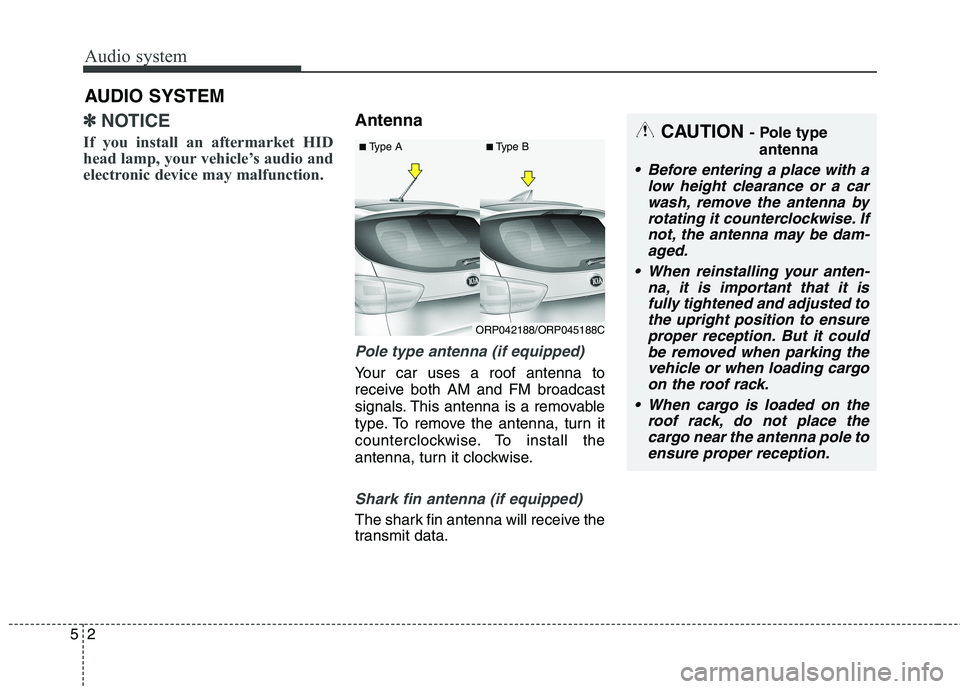2017 KIA CARENS RHD roof rack
[x] Cancel search: roof rackPage 282 of 723

Features of your vehicle
186
4
EXTERIOR FEATURES
Roof rack (if equipped)
If the vehicle has a roof rack, you can
load cargo on top of your vehicle.
We recommend to obtain the cross- bars and fixing components needed
to install the roof rack on your vehicle
from an authorised Kia dealer.
✽✽ NOTICE
The crossbars (if equipped) should be placed in the proper load carry-
ing positions prior to placing items
onto the roof rack.
If the vehicle is equipped with a sunroof, be sure not to position
cargo onto the roof rack in such a
way that it
could interfere with sun-
roof operation.
When the roof rack is not being used to carry cargo, the crossbars
may need to be repositioned if wind
noise is detected.
ORP042187
CAUTION
When carrying cargo on the
roof rack, take the necessaryprecautions to make sure the cargo does not damage theroof of the vehicle.
When carrying large objects on the roof rack, make surethey do not exceed the overall roof length or width.
When you are carrying cargo on the roof rack, do not operatethe sunroof (if equipped).
Page 283 of 723

4187
Features of your vehicle
WARNING
The following specification is the maximum weight that can
be loaded onto the roof rack.
Distribute the load as evenly as
possible across the crossbars
(if equipped) and roof rack and
secure the load firmly.
Loading cargo or luggage in
excess of the specified weight
limit on the roof rack may
damage your vehicle.
The vehicle centre of gravity will be higher when items are
loaded onto the roof rack.
Avoid sudden starts, braking,
sharp turns, abrupt manoeu-
vres or high speeds that may
result in loss of vehicle con-
trol or rollover resulting in anaccident.
(Continued)
ROOF 100 kg (220 lbs.)
RACK EVENLY DISTRIBUTED
(Continued)
Always drive slowly and turn
corners carefully when carry-
ing items on the roof rack.
Severe wind updrafts, caused
by passing vehicles or natural
causes, can cause sudden
upward pressure on items
loaded on the roof rack. This
is especially true when carry-
ing large, flat items such as
wood panels or mattresses.This could cause the items to
fall off the roof rack and cause
damage to your vehicle or
others around you.
To prevent damage or loss of cargo whilst driving, check
frequently before or whilstdriving to make sure the items
on the roof rack are securelyfastened.
Page 285 of 723

Audio system
2
5
✽✽
NOTICE
If you install an aftermarket HID
head lamp, your vehicle’s audio and
electronic device may malfunction.Antenna
Pole type antenna (if equipped)
Your car uses a roof antenna to
receive both AM and FM broadcast
signals. This antenna is a removable
type. To remove the antenna, turn it
counterclockwise. To install the
antenna, turn it clockwise.
Shark fin antenna (if equipped)
The shark fin antenna will receive the
transmit data.
AUDIO SYSTEM
CAUTION
- Pole type
antenna
• Before entering a place with a low height clearance or a carwash, remove the antenna by rotating it counterclockwise. Ifnot, the antenna may be dam-aged.
When reinstalling your anten- na, it is important that it isfully tightened and adjusted tothe upright position to ensureproper reception. But it could be removed when parking thevehicle or when loading cargoon the roof rack.
When cargo is loaded on the roof rack, do not place thecargo near the antenna pole toensure proper reception.
ORP042188/ORP045188C
■
Type A ■Type B
Page 598 of 723

811
Maintenance
SCHEDULED MAINTENANCE SERVICE
Follow Normal Maintenance
Schedule if the vehicle is usually
operated where none of the following
conditions apply. If any of the following
conditions apply, follow Maintenance
Under Severe Usage Conditions.
Repeated driving short distance of less than 8 km (5 miles) in normal
temperature or less than 16 km(10
miles) in freezing temperature
Extensive engine idling or low speed driving for long distances
Driving on rough, dusty, muddy, unpaved, graveled or salt-spreadroads
Driving in areas using salt or other corrosive materials or in very cold
weather
Driving in the condition of inflowing sand or dust into engine
Driving in heavy traffic area
Driving on uphill, downhill, or mountain road repeatedly
Towing a trailer or using a camper, or roof rack Driving as a patrol car, taxi, other
commercial use of vehicle towing
Driving over 170 km/h (106 mile/h)
Frequently driving in stop-and-go condition
If your vehicle is operated under the
above conditions, you shouldinspect, replace or refill more fre- quently than the following NormalMaintenance Schedule. After theperiods or distance shown in the chart, continue to follow the pre-scribed maintenance intervals.
Page 605 of 723

Maintenance
18
8
Severe driving conditions
A : Repeatedly driving short distance of less than 8 km (5
miles) in normal temperature or less than 16 km (10 miles)
in freezing temperature.
B : Extensive engine idling or low speed driving for long dis- tances.
C : Driving on rough, dusty, muddy, unpaved, graveled or salt- spread roads.
D : Driving in areas using salt or other corrosive materials or in very cold weather. E : Driving in heavy dust condition.
F : Driving in heavy traffic area.
G : Driving on uphill, downhill, or mountain roads repeatedly.
H : Towing a trailer or using a camper on roof rack.
I : Driving for patrol car, taxi, commercial car or vehicle towing.
J : Driving over 170 km/h (106 mile/h).
K : Frequently driving in stop-and-go conditions.
Maintenance itemMaintenance
operationMaintenance intervalsDriving Condition
Front suspension ball jointsIInspect more frequently depending on the conditionC, D, E, F, G
Disc brakes and pads, calipers and rotorsIInspect more frequently depending on the conditionC, D, E, G, H
Parking brake (Hand type)IInspect more frequently depending on the conditionC, D, G, H
Drive shaft and bootsIInspect more frequently depending on the conditionC, D, E, F,
G, H, I, J, K
Climate control air filter RReplace more frequently depending on the conditionC, E, G
Spark plugsRReplace more frequently depending on the conditionB, H, I, K
Page 614 of 723

827
Maintenance
Severe driving conditions
A : Repeatedly driving short distance of less than 8 km (5miles) in normal temperature or less than 16 km (10 miles)
in freezing temperature.
B : Extensive engine idling or low speed driving for long dis- tances.
C : Driving on rough, dusty, muddy, unpaved, graveled or salt- spread roads.
D : Driving in areas using salt or other corrosive materials or in very cold weather. E : Driving in heavy dust condition.
F : Driving in heavy traffic area.
G : Driving on uphill, downhill, or mountain roads repeatedly.
H : Towing a trailer or using a camper on roof rack.
I : Driving for patrol car, taxi, commercial car or vehicle towing.
J : Driving over 170 km/h (106 mile/h).
K : Frequently driving in stop-and-go conditions.
Maintenance itemMaintenance
operationMaintenance intervalsDriving condition
Steering gear rack, linkage and bootsIInspect more frequently
depending on the conditionC, D, E, F, G
Front suspension ball jointsIInspect more frequently
depending on the conditionC, D, E, F, G
Disc brakes and pads, calipers and rotorsIInspect more frequently
depending on the conditionC, D, E, G, H
Parking brake (Hand type)IInspect more frequently
depending on the conditionC, D, G, H
Driveshaft and bootsIInspect more frequently
depending on the conditionC, D, E, F, G, H, I, J
Climate control air filterRReplace more frequently
depending on the conditionC, E, G
Spark plugsRReplace more frequently
depending on the conditionB, H, I, K
Page 716 of 723

Index
4
I
To cancel cruise control ..............................................6-67
To decrease the cruising speed ..................................6-66
To increase cruise control set speed ..........................6-66
To resume cruising speed at more than approximately 30 km/h (20 mph) ............................6-68
To set cruise control speed..........................................6-65
To temporarily accelerate with the cruise control on ....6-67
To turn cruise control off ............................................6-68
Declaration of conformity ............................................9-13
Defroster ......................................................................4-138 Rear window defroster ..............................................4-138
Dimensions ......................................................................9-2
Door locks......................................................................4-23 Child-protector rear door lock ....................................4-29
Deadlocks....................................................................4-27
Door lock/unlock features ..........................................4-28
Operating door locks from inside the vehicle ............4-24
Operating door locks from outside the vehicle ........4-23
Dual Clutch Transmission (DCT) ................................6-34 Dual clutch transmission operation ..........................6-34
Good driving practices ................................................6-41
Economical operation ....................................................6-90 Emergency Commodity ................................................7-37
Fire extinguisher ........................................................7-37
Triangle reflector ......................................................7-37
Emergency starting ..........................................................7-5 Jump starting ..............................................................7-5
Push-starting ..............................................................7-7
Emission control system ..............................................8-109 Crankcase emission control system ..........................8-109
Evaporative emission control System ......................8-109
Exhaust emission control system ..............................8-110
Lean NOx Trap ........................................................8-112
Engine ..............................................................................9-2
Engine compartment ................................................2-6, 8-3
Engine coolant ..............................................................8-34 Changing the coolant ..................................................8-37
Checking the coolant level ....................................8-34
Engine number ..............................................................9-12
Engine oil ......................................................................8-32 Changing the engine oil and filter ..............................8-33
Checking the engine oil level ....................................8-32
ENGINE START/STOP button ....................................6-10 Engine start/stop button position ................................6-10
Illuminated engine start/stop button ..........................6-10
Starting the engine ......................................................6-13
Explanation of scheduled maintenance items ..............8-28
Exterior features ..........................................................4-186 Roof rack ..................................................................4-186
Exterior overview ............................................................2-2
D
E